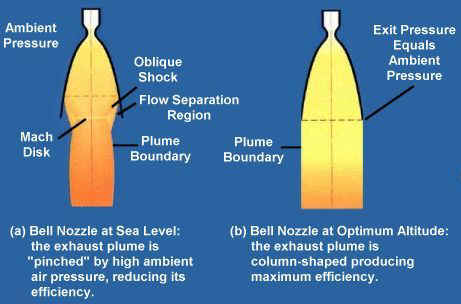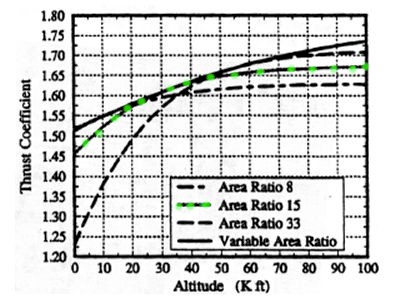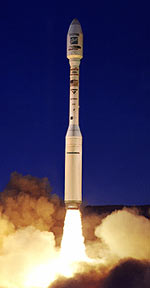SKY RAMP TECHNOLOGY
A major obstacle to the construction of Sky Ramps is the political power of existing sea level spaceports, particularly the Kennedy Space Center in Florida. This can be countered by explaining that NASA made an error constructing sea level spaceports because launching from higher altitudes can boost the payload of any space vehicle. Launching at higher altitude allows rocket engines to produce more thrust because the thinner air allows a better plume, the vehicle pushes against less air density at launch, and Max Q is less a factor. There are several promising mountaintop locations along the California-Nevada border at over 13,000 feet, with nothing downrange to the east except the massive Nevada Test and Training Range, and little population to the south for polar launches. Colorado and New Mexico have mountains of similar size, yet their downrange azimuths are less vacant. Launching at 13,000 feet from the big island of Hawaii nearer the Equator is best, but requires shipping rockets to Hawaii.
Experts understand the minor advantage of less air resistance at higher altitudes, although many do not realize the atmosphere is 39% thinner at just 13,000 feet. Rocket engine experts understand that rocket nozzle design is a compromise, and that rockets burn more efficiently at higher altitude. Current rocket engines with bell nozzles lose thrust at sea level because the thick air pinches their plume. This resulted in enthusiasm for an aerospike engine for the X-33 that was designed to burn efficiently at all altitudes. Great progress was made, yet the aerospike was heavy and complex, so the effort ended when the X-33 was cancelled in 2001.

Bell nozzle behavior during flight [from Rocketdyne, 1999]
While NASA spent millions of dollars on aerospike research and development, no one considered the option of simply launching at higher altitude. The Russians are aware of this advantage since their spaceports are several thousand feet above sea level. Fortunately, aerospike research provides information on the value of high altitude launches. The chart below is explained in detail at this website: Altitude Compensation.

"Area Ratio 15" is the optimum nozzle size compromise used by rockets now launched at sea level. As you can see, a rocket's thrust coefficient at sea level is 1.46, whereas it could burn at 1.54 at 13,000 feet, an increase in efficiency of 5.2% (1.46/1.54-1) By the time a sea level launched rocket is at 20,000 feet with a thrust coefficient of 1.57, a rocket launched at 13,000 feet would be at 33,000 feet and 1.62, burning 3.1% more efficiently. (1.57/1.62-1) When a sea level rocket reaches 40,000 feet with a thrust coefficient of 1.63, a rocket launched at 13,000 feet would be at 53,000 ft and 1.65, burning 1.2% more efficiently (1.63/1.65-1). Efficiency continues to shrink until the atmosphere becomes so thin after 70,000 feet that nothing is gained.
This is a simplified example that clearly shows an efficiency gain during the first minute of flight. Keep in mind that rockets burn much longer just after launch at lower altitudes until they gain velocity. The new Atlas V "401" burns for 17 seconds just to reach 800 feet. The chart below illustrates the advantage of high altitude launch because of less air density and more efficient rocket plumes.
Altitude
Pressure Ave.Temp. Less
Air Greater Thrust
(ft) (in. Hg)
(F.)
Density at Launch
0
29.92 59.0
0. 0%
0.0%
5,000 24.89
41.2
16.8%
2.7%
10,000 20.57
23.3
31.3%
3.9%
15,000 16.88
5.5
43.6%
5.8%
20,000 13.74
-12.3
54.1%
7.0%
25,000 11.10 -30.15 62.9% 8.2%
30,000 8.89 -47.98 70.3% 9.3%
So how much is really gained from mountaintop launch? For an example, the first stage of the Atlas V 401 burns for 236 seconds up to 370,000 feet. If that rocket where launched at 13,000 feet, it would burn for ~90 seconds to reach 70,000 feet ~4 % more efficiently than one launched at sea level. So 90 seconds x 2657 lbs of fuel a second = 239,130 lbs, and with a savings of 4 % = 9565 lbs of fuel saved. Since the Atlas V 401, puts just 9000 lbs of payload into GTO, this small fuel savings is significant. All of this fuel savings does not equate to greater payload since the second and third stages have more mass to accelerate. Nevertheless, just this small boost will result in ~1000 lbs more payload into orbit depending on final altitude and velocity.
Launching the Atlas V family of expendable rockets at high altitude would require fewer $5 million strap-on boosters, depending on the configuration. Since the Atlas V "Heavy" uses two common core boosters to reach 70,000 feet, the fuel savings doubles to over 20,000 lbs. Mountaintop launches of massive non-aerodynamic vehicles like the Space Shuttle may allow them to double payload. Even savings from launching small expendables at higher altitude are significant. The US Air Force provides a
billion dollar a year subsidy to Boeing and Lockheed Martin since their new expendable rockets systems are not profitable, while NASA spends billions more
on dubious projects. In addition, most of America's rocket manufacturing is
done in California, Utah, Colorado, and Arizona, so shipping to the Rocky Mountains
is cheaper than to
Florida, even with the steep rail ride up a mountain. Spending a billion dollars
on infrastructure improvements to a remote area of the USA is a real
investment that will benefit growth in an undeveloped area. While the
weather at 13,000 feet is cold and often snowy, coastal weather is worse.
Florida is pummeled by heavy rains and occasional hurricanes. Moreover,
high humidity causes rust problems on buildings and equipment, while security
and local air traffic are a headache. Most of a mountain spaceport would
be located at lower elevations anyway, with just the launch pad up high at the
end of a rail-tram line, like those used by mining companies. 
A final advantage to mountaintop launches is eliminating the need to throttle down the engines on most spacecraft when maximum dynamic pressure "Max Q" is reached. This is where the velocity of an ascending spacecraft becomes so great that air resistance may cause structural damage. As a result, acceleration is lost as engines are throttled back at the "Max Q" limit, and then increased as the spacecraft ascends when air is less dense. The new Altas V 551 provides an excellent example. It hits Max Q around 30,000 feet where its main engine is quickly throttled down to 60% thrust for some 30 seconds. This introduces complexity and limits the vehicles ability to accelerate efficiently. Launching from a mountaintop may eliminate this need entirely. This Max Q exemption is also helpful for spacecraft launched from Sky Ramps.
These advantages are yet another reason to build a Sky Ramp launch system. If a Sky Ramp is used, all the spaceport would be at much lower elevation. While the Sky Ramp concept is too innovative for the Space establishment, static launching of proven expendable systems vertically at 13,000 feet provides significant advantages. Therefore, funding may be found for a small, experimental, mountaintop spaceport, which can launch smaller solid rocket vehicles designed to be easily transportable and launched from austere sites, like the "Taurus" made by Orbital Sciences (above). A mountaintop spaceport can also experiment with tower or short ramp assisted launches using pneumatic systems or gravity-cable techniques to boost an expendables payload.
If funding is an issue, what's the point of operating five sea level spaceports: Kennedy, Vandenberg, Wallops, Kodiak, and Kauai? Why not close one of these spaceports to fund a mountaintop spaceport? The wealthy residents near Vandenberg complain about noise, so perhaps its time to phase out that facility. And don't assume Hawaiians will oppose a launch site on their mountains. There are few good jobs on the island of Hawaii, and most locals wouldn't mind if a launch pad was built one of their barren, inaccessible peaks. Launching from 13,000 feet near Mauna Loa peak offers clear azimuths to the east and south. From an environmental standpoint, launching rockets near beaches, people, and wildlife at sea level is much worse than barren, uninhabited mountaintops where the danger of bird strikes or off-course small aircraft are nil.Many of the US Navy's most innovative weapons and equipment were developed at the remote China Lake Research Center. Their success is attributed to their distance from traditional bureaucracies, which block or meddle with innovative programs until they are killed. When someone first recommended that space telescope observatories be built on high mountains where the air is thinner, there was criticism of weather problems and higher construction costs, yet scientists prevailed and they are all built as high as possible today. A remote experimental mountaintop spaceport is what America's needs to move ahead. The advantage of higher attitude launches is undisputed, and a new mountaintop spaceport can also test future options for ground assisted launches like Sky Ramps.
©2008 Sky Ramp Technology